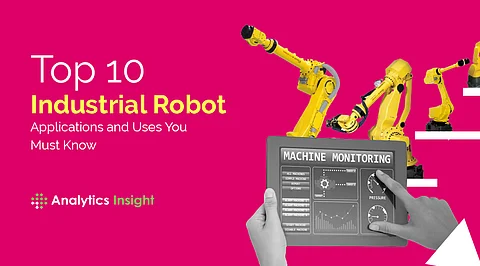

Industrial robots are one of today's best inventions, with numerous applications in factories, warehouses, and industries. Industrial robots are fully automated, programmable, and can move on three or more axes. Industrial Robots applications and uses include many. Some industrial robot applications include Loading and Unloading, Arc Welding, Spot Welding, Painting Investment Casting, etc.
Industrial robots are similar to humans in having multiple joints, articulations, and manipulators that can be programmed to perform a specific task efficiently and quickly. Furthermore, industrial robots help to achieve cost synergies and reduce waste. These Industrial Robot uses are in manufacturing, machinery, and assembly industries because they are motorized, and provide fast, consistent performance in heavy-duty or repetitive tasks. Automated robot parts are used for basic tasks in a wide range of industries and workplaces. These robots are made of strong and durable metal, usually steel or cast iron.
Let us look at the various applications of industrial robots and the types of robots used in each industrial robot application:
Small parts must be assembled into larger units as part of the manufacturing process. Previously, the such assembly could only be accomplished through the combination of human dexterity, vision, and intelligence. Robots that can dispense bonding agents are a related technology because many assembly processes require adhesives.
The process of forming metallic objects by injecting liquid metal into a die or cavity shaped in the shape of the object to be made is known as casting. Molding is similar to casting except that the material used is usually plastic. These include die-casting robots, Injection molding robots, and Deburring, Grinding, and Polishing Robots.
Industrial facilities must be kept clean for the sake of the finished product's quality as well as the health and safety of those who work there. Cleaning is a time-consuming and frequently repeated task. The Cleaning Robots, Disinfection robots, and Industrial Robot Vaccums help in cleaning, Sanitation, and removing dust and debris from industrial facilities autonomously.
Moving objects around a warehouse or taking items out of a tote and placing them in a shipping container are examples of handling and picking robots. Due to the growth of e-commerce, robots that can pick and fill orders are in high demand. Material handling robots, Pick and Place robots, and Order Picking Robots are considered autonomous mobile robots (AMRs).
Order picking, packing, sorting, labeling, and transportation are just a few of the many operations that robots in a warehouse or distribution center may automate. The Delivery robots which resemble wheeled carts are used to distribute meals in urban areas. Other delivery robots resemble humans in that they stand on two legs, and have arms, and dome-shaped bodies.
Some quality control concerns are life and death, because a faulty part or an incorrectly placed part may result in a scenario that puts the user's life in jeopardy. The human examination is frequently only 80% accurate. Industrial robot applications have the potential to be completely precise. For example, Vision Robots can inspect a variety of qualities, such as the presence of fractures, dimension measurement, and coating uniformity.
In a manufacturing or machine tool shop, robots can automate a variety of repetitive tasks. Machine tending robots place workpieces inside machine tools and remove them once an operation is completed. Milling robots help CNC automation by allowing for automatic tool replacement and unsupervised operation. With Laser cutting robots, the material is less likely to deform, and accuracy may be improved because the laser beam does not lose effectiveness over time.
Industrial painting and coating is the process of applying paint or other coatings to a workpiece. Because the component that must be painted or coated in production has a clearly defined shape and size, the painting and coating procedures are quite repetitive. As a result, industrial robot applications are well suited to painting and coating tasks.
Packing and palletizing are tasks performed by manufacturing, warehouses, and distribution facilities. As the trend towards smaller items continues, the packing and palletizing processes become more repetitive. For example, Packaging robots can autonomously produce boxes in a variety of sizes as needed whereas these boxes and containers may be stacked neatly and efficiently on a pallet using palletizing robots.
Soldering robots are widely used in the consumer and commercial electronics sectors. They can also be found in automotive, aerospace, and medical device manufacturing plants.
Because soldering applications have a small footprint, manufacturers use a variety of robots to perform this task. Several types of robots are commonly used in soldering applications: Cartesian, sSCARA, Six-axis.
Join our WhatsApp Channel to get the latest news, exclusives and videos on WhatsApp
_____________
Disclaimer: Analytics Insight does not provide financial advice or guidance. Also note that the cryptocurrencies mentioned/listed on the website could potentially be scams, i.e. designed to induce you to invest financial resources that may be lost forever and not be recoverable once investments are made. You are responsible for conducting your own research (DYOR) before making any investments. Read more here.
